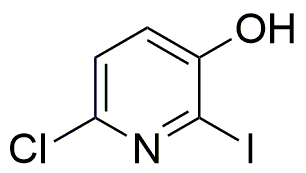6-Chloro-2-iodo-3-hydroxypyridine is widely utilized in research focused on:
- Pharmaceutical Development: This compound serves as an important intermediate in the synthesis of various pharmaceuticals, particularly in creating drugs targeting neurological disorders.
- Agricultural Chemicals: It is used in the formulation of agrochemicals, enhancing the effectiveness of pesticides and herbicides, which helps in improving crop yields.
- Material Science: The compound is explored for its potential in developing new materials, particularly in coatings and polymers that require enhanced durability and chemical resistance.
- Biochemical Research: Researchers utilize it in studies related to enzyme inhibition and receptor binding, contributing to a better understanding of biological processes.
- Analytical Chemistry: It acts as a standard reference material in analytical methods, aiding in the calibration of instruments and ensuring accurate measurements in various chemical analyses.
Información general
Propiedades
Seguridad y normativas
Aplicaciones
6-Chloro-2-iodo-3-hydroxypyridine is widely utilized in research focused on:
- Pharmaceutical Development: This compound serves as an important intermediate in the synthesis of various pharmaceuticals, particularly in creating drugs targeting neurological disorders.
- Agricultural Chemicals: It is used in the formulation of agrochemicals, enhancing the effectiveness of pesticides and herbicides, which helps in improving crop yields.
- Material Science: The compound is explored for its potential in developing new materials, particularly in coatings and polymers that require enhanced durability and chemical resistance.
- Biochemical Research: Researchers utilize it in studies related to enzyme inhibition and receptor binding, contributing to a better understanding of biological processes.
- Analytical Chemistry: It acts as a standard reference material in analytical methods, aiding in the calibration of instruments and ensuring accurate measurements in various chemical analyses.
Documentos
Hojas de datos de seguridad (HDS)
La SDS proporciona información de seguridad completa sobre la manipulación, el almacenamiento y la eliminación del producto.
Especificación del producto (PS)
La PS proporciona un desglose completo de las propiedades del producto, incluida la composición química, el estado físico, la pureza y los requisitos de almacenamiento. También detalla los rangos de calidad aceptables y las aplicaciones previstas del producto.
Certificados de análisis (COA)
Busque certificados de análisis (COA) ingresando el número de lote del producto. Los números de lote y de partida se pueden encontrar en la etiqueta de un producto después de las palabras "Lote" o "Lote".
Número de catálogo
Número de lote/lote
Certificados de origen (COO)
Este certificado de origen confirma el país en el que se fabricó el producto y también detalla los materiales y componentes utilizados en él y si se deriva de fuentes naturales, sintéticas u otras fuentes específicas. Este certificado puede ser necesario para cumplir con las normativas aduaneras, comerciales y regulatorias.
Número de catálogo
Número de lote/lote
Hojas de datos de seguridad (HDS)
La SDS proporciona información de seguridad completa sobre la manipulación, el almacenamiento y la eliminación del producto.
DownloadEspecificación del producto (PS)
La PS proporciona un desglose completo de las propiedades del producto, incluida la composición química, el estado físico, la pureza y los requisitos de almacenamiento. También detalla los rangos de calidad aceptables y las aplicaciones previstas del producto.
DownloadCertificados de análisis (COA)
Busque certificados de análisis (COA) ingresando el número de lote del producto. Los números de lote y de partida se pueden encontrar en la etiqueta de un producto después de las palabras "Lote" o "Lote".
Número de catálogo
Número de lote/lote
Certificados de origen (COO)
Este certificado de origen confirma el país en el que se fabricó el producto y también detalla los materiales y componentes utilizados en él y si se deriva de fuentes naturales, sintéticas u otras fuentes específicas. Este certificado puede ser necesario para cumplir con las normativas aduaneras, comerciales y regulatorias.


